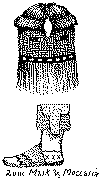
Song No. 15
Zuni Sunset Song
Rain Dance of Zuni
This dance is always performed at the Pueblo of Zuni on August 19th. Both men and women participate, and all are masked.
The men have long, waved hair; the women wear the hair wrapped at each side with colored worsted around an oblong of cardboard.

Fig. 38.
The mask of the men is turquoise in color-a straight strip about 6 inches deep, and reaching from ear to ear across the face. At the bottom is a band of painted rectangles, alternately red, blue, and yellow. From this band hangs a horsehair fringe, long enough to hide the throat. There are three white feathers at the top of the mask, one hanging over the face at the middle of the top, and one over each ear. They wear a tuft of macaw feathers on top of the head. (Fig. 38.)
The mask of the women is similar, but white instead of turquoise, and with no colored band above the fringe. There is a short fringe of goat hair around the whole head at the top of the mask. A soft white eagle feather falls over the face, attached above the top fringe.
The men were dressed as follows: The upper body was nude, except for paint, much as in the CORN DANCE, and strings of beads about the neck. A white embroidered apron, and a white knitted sash with ends embroidered in red, black and white. A fox skin hung down the back from the waistline, and evergreens stuck into the belt all around. On the left wrist, a bracelet of silver or leather; the right wrist wrapped in a hank of worsted.
Bare legs, with a tortoise shell rattle tied back of the right knee, and a wide red garter embroidered in white. The left knee tied with black (in some cases dark blue) worsted. Moccasins of bright turquoise blue, about s inches high; a turnover of orange at top of either side; trimming of scallops across the front; and a band about r %2 inches wide of quill work tied around the back. (Fig. 3 6. )
The women were dressed as follows: Absolutely no part of the body or face showed except the feet which were bare. Even the hands werc covered by the shawl. A black dress as in the CORN DANCE, with whit embroidered underskirt showing about z inches. Over the dress, each wore a bright Spanish shawl, some red, some yellow, some flowered, etc. These varied in color and pattern; but over them, each wore another shawl. These over-shawls were square, and of two styles: one all black, the other white, with a border about r o inches wide top and bottom, of red, striped lengthwise with four hair-lines of white. They wore stock-
86
x x'
UM,
27 Nsk %~
They worked in two lines, about 4 feet apart, all women in one line,
all men in the other.
The main step was alike for both men and women, though a little more vigorously done by the men: Step left foot, step right a little higher, progressing a few inches forward.
They did not work in a circle; but in each of the three figures, progressed along two sides of the quadrangle of the pueblo.
8a
Carlos Troyer-Pub. by Theo. Presser Co., Phila.
Fig. 1
(a) Men and women all facing right, to one singing of the song
(b) Continue the step in same rhythm for 8 double steps, but without music
(c) Then the women start the song again, while the men yelp in time (2 yelps to the measure)
(d) All continue the song to the end
Fig. 11
(a) Men and women facing each other, progression being sidewise
I9 meas.
8 meas.
I t meas.
(b), (c), and (d) as (b), (c), and (d) of Fig. 1 I9 meas.
Fig. 111 (a) Men and women all facing left
I9 meas.
(b), (c), and (d) as (b), (c), and (d) of Fig. 1 z9 meas. 88
There was no drum or tom-tom, but all sang in a loud-soft rhythm. During the singing rests, the time was kept by the clatter of the shells, and the very distinct patter of the moccasined feet.
Zuni Nick says the song varies from year to year, and it is the privilege of all to improvise the new song for each RAIN DANCE.
89